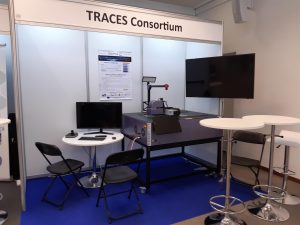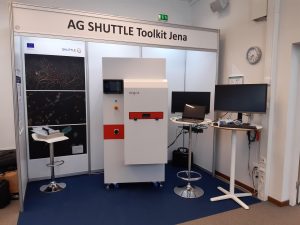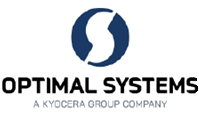Phase 3 runs from August 2021 until July 2022. During this Phase, the prototypes developed during the PCP Phase 2 will be validated in operational environment to check their compliance with the requirements defined in the Tender Documentation.
Phase 3 – Operational Validation – Successful Contractors
Traces Consortium
 In the framework of the Shuttle PCP, the TRACES Consortium developed a high-throughput screening microscope and a toolkit for the collection and the automated analysis of crime scene traces, the SMMART forensics toolkit. The toolkit includes an adhesive non-birefringent, non-fluorescing, optically clean tape that it is used to collect both visible and invisible traces, when it comes in contact with crime field surfaces. It further includes a multimodal microscope integrating a hybrid hyperspectral camera acquiring color, hyperspectral and combined spectral/polarization images. Scanning is carried out in a fully automated fashion, implementing scenarios selected by the user. The SMMART system’s image handling suite includes the Data Viewer, the Database and the Analysis software modules, that can be operated independently or in connection.
In the framework of the Shuttle PCP, the TRACES Consortium developed a high-throughput screening microscope and a toolkit for the collection and the automated analysis of crime scene traces, the SMMART forensics toolkit. The toolkit includes an adhesive non-birefringent, non-fluorescing, optically clean tape that it is used to collect both visible and invisible traces, when it comes in contact with crime field surfaces. It further includes a multimodal microscope integrating a hybrid hyperspectral camera acquiring color, hyperspectral and combined spectral/polarization images. Scanning is carried out in a fully automated fashion, implementing scenarios selected by the user. The SMMART system’s image handling suite includes the Data Viewer, the Database and the Analysis software modules, that can be operated independently or in connection.
To summarize, the SMMART forensics toolkit includes:
- The SMMART High Throughput Screening (HTS) microscope
- The SMMART Tape lifting System (TLS)
- The SMMART Data Viewer (DV) software
- The SMMART Analysis software
- The SMMART Database (DB)
What are the key innovation factors?
The key factors of innovation of the SMMART forensics toolkit are:
- new sophisticated, long working distance, ultrahigh resolution multimodal automated digital microscope
- hyperspectral imager offering real-time spectral imaging and a full spectrum per image pixel in a wide spectral range spanning Ultraviolet, Visible and Near Infrared bands
- real time color imaging in all offered imaging modes: transmission, reflection, fluorescence and polarization
- real time hyperspectral imaging in transmission
- real time, rotation independent, spectral retardation mapping
- extra-large sample holding platform with the capacity of accepting panels with collected traces of a 600X420mm total area, with the scanning system and the imaging optics offering non-destructive analysis at the sub-micron level
- projection system projecting light-markings over the identified samples, from a laser light source or (optional) a laser projector, for navigating secondary sampling of traces eligible for subsequent analyses
- forensics grade traces lifting system, combining unobstructed optical analysis and collection/storage/maintenance of traces even in extreme environments
- advanced data analysis software suite implementing modern machine learning algorithms that process the acquired optical data (spectra, polarization states, etc.) and output fully automated (unsupervised and supervised) identification of traces over the total scanned area
- sample detection intelligence, based on real time recognition techniques, that reduces overall scanning time and prevents the storage of void areas
- real time execution of analysis algorithms running concurrently with the acquisition, that eliminates the need for offline analysis time
- novel scheme for the storage of all acquired data and the results of the analyses in a highly versatile and secure database environment
- fully automated operation of the complete system without requiring technical background
What are your main results in Phase 3:
- Production of four fully functional prototypes (three for the sites and one for their support and for demo)
- Production of several hundreds of tape/backing films and send to sites for SAT validation
- Operation Manual drafted and shared
- Installations and first round training started in time and completed successfully in the three sites
- Continuous technical support offered either with physical presence or remotely, with a few days reaction time
- Continuous training of the end users.
- Provide assistance for the Site Acceptance Tests (SAT)
- Participation with presentation and Demo device showcasing in the European conference EAFS 2022
- Promotional and educational material (brochure, video, website, etc) developed and distributed in EAFS conference and elsewhere
- The UK Defense and Security Accelerator provided the funds for the acquisition and installation of the SMMART-forensics toolkit in the UK
What’s next:
The SMMART forensics toolkit is at the final stage of its development. Towards a wide scale commercialization, the TRACES Consortium’s market penetration strategy involves “three waves” of market penetration to adapt to the different profiles of our customers:
- First wave: Forensics & Research experts and Education Institutions
- Second wave: Regional departments of forensics laboratories
- Third wave: Private companies providing services across Europe
The Consortium:
| SPECTRICON S.M. PC www.spectricon.com |
Zanasi & Partners www.zanasi-alessandro.eu |
AG SHUTTLE TOOLKIT JENA
 Since phase 1 of the SHUTTLE process, we have pursued the goal of implementing the required specifications with an innovative approach. This consists of imaging the material of a trace carrier:
Since phase 1 of the SHUTTLE process, we have pursued the goal of implementing the required specifications with an innovative approach. This consists of imaging the material of a trace carrier:
- completely,
- with the required optical resolution and
- in all required spectral modes.
The resulting images are analyzed and organized by the Toolkit program. Image stacks are evaluated and classified by means of Artificial Intelligence (AI). Images and classification results are stored in an Enterprise Content Management System (ECM).
This solution approach has the decisive advantage that all alleged traces are digitally recorded and in case of a follow-up examination (e.g. because newer material data are available), this can be carried out with the stored data. The solution to be presented here largely fulfills all technical specifications – almost all technical parameters can be expanded.
What are the key innovation factors?
We ensure the complete image capture with a 150MP sensor and corresponding optics, which can record an area of 53,4 x 40,0 mm² for the required S- and P-images (LoRes) and 17,8 x 13,3 mm² for M- and F-images (HiRes). The achievable optical resolution is 10μm and 3μm, respectively. The spectral material properties are captured by an image stack of monochromatically illuminated single images, so that spectra of single (pixel) positions or pixel groups (e.g. of detected or/and classified objects) can be generated afterwards. The same principle is applied for the acquisition of wavelength depended polarization properties to get an image of retardance values.
The AI that processes the HiRes images in the current development stage is able to perform classifications. The reliability of the classification result depends exclusively on the amount and variety of training data with which the AI has been “trained”. By the way, this learning process can be accelerated if several users exchange training data (and no case data) among each other and update them again and again. Outside the framework of the PCP, specialized AI libraries can be supplied for topics such as fibers from certain manufacturers and their properties or other.
The database – more precisely: the “Enterprise Content Management System” is able to store all properties measured or calculated directly or indirectly by the system or by the user. These data are then available to the user for research/screening/statistics/ and more.
All the above-mentioned main components – optics/mechanics, AI and ECM – are modular in design and can be expanded to include further components.
Taken together, the advantage of our solution is:
- The outcome of all traces is completely stored digitally for future use
- You can merge the knowledge of different persons on various locations to get best decision based on all available consolidated experience
- But nevertheless you can use the Toolkit for stand-alone use in connection with your other proven tools.
What are your main results in Phase 3:
Our consortium succeeded in building three prototypes that run in the laboratories of IRCGN, MOPS and PJ and were subject to the Site Acceptance Tests organised by SHUTTLE. Moreover, the consortium updated its in-house prototype to a functionally identical state with the Toolkits in the field.
Overall, the following goals were achieved:
- The Toolkit works fully automated and measures in all modes.
- It includes a magazine for automated sample feed.
- An RGB transmission mode for M imaging has been introduced to the Toolkit and serves for instance for contouring of the objects.
- The motor controls have been adjusted in an appropriate manner to minimize the system’s noise level.
- The Toolkit can be moved as a whole. It is delivered together with a dedicated sample preparation workplace and a client PC that can be put at the user’s convenience elsewhere in the lab or in a neighbouring office.
- Essential functions for providing image quality are fully developed and integrated into the Toolkit, namely focus stacking, auto exposure, image alignment and white balance.
- A calibration curve for spectral imaging has been implemented.
- A dedicated preparation site has been elaborated. It is equipped with a function that takes an overview image from the sample and transfers it to the Graphical User Interface (GUI) to help the user select ROIs. Furthermore, it automatically recognizes and transmits the barcode of the sample to the GUI.
- A basic protocol for relocating a trace on the sample carrier after measurement and isolating has been established.
- A feature that allows for RGB trace color calculation; trace color can be an indicator for trace rarity within the context of, e.g., an acquisition. This, in turn, could be of high evidential value depending on the context of a criminal investigation.
- The ECM database realizes image storage, processing and the data flow to and from AI and GUI as well as backup functionality. A management of micro-services is implemented for several image processing and analyzing functions, which can be supplement-ed with custom extensions.
- The GUI provides security, offers different user roles, gives control of the working process and presents the acquired data to the user. Furthermore, additional functions that exceed those required by the specifications were added.
- The AI is implemented with trace recognition and required classification functions. Until now the processing of RGB images is used (only 3 channels from designed 8). Classification is reached through successive application of two AI models, one a basic classifier and one for fibers. The full potential of AI for this Toolkit will be achieved a) with further training and b) through implementation of more image channels like fluorescence, spectral and retardance images.
What’s next:
Necessary subsequent certifications and labeling have had special attention throughout the development process, so that these activities (certifications and labeling) are well prepared and an integral part of our plan for commercialization. With the completion and installation of three devices and one device on the same level for further tests and trouble-shooting at the end of phase 3, we are in a position to participate in pitches with concrete results and facts about the product’s performance, either to raise additional capital or/and to start developing distribution channels. This includes presenting ourselves on an international stage.
In 2021 we demonstrated the Toolkit at the VISION fair in Stuttgart, Germany, at the congress of the German forensic Fiber Group in Erfurt, Germany, and in 2022 the European Academy of Forensic Science Conference EAFS on Stockholm, Sweden. There we obtained feedback from relevant users that show us which specific properties of our Toolkit are valuable for them and that they expect us to proceed to market.
Especially the AI functionality is acknowledged to be particularly relevant to the market. There is a good chance to cooperate in sales with global players in the analytical forensic business. The new product would extend their existing product range and these companies have an additional good market coverage and access. This is even more important in terms of later service and support in local markets
The Consortium:
 |
 |
|
| aura optik gmbh www.aura-optik.de |
OPTIMAL SYSTEMS www.optimal-systems.de/en |
AI-UI GmbH ai-ui.ai/en/ |

